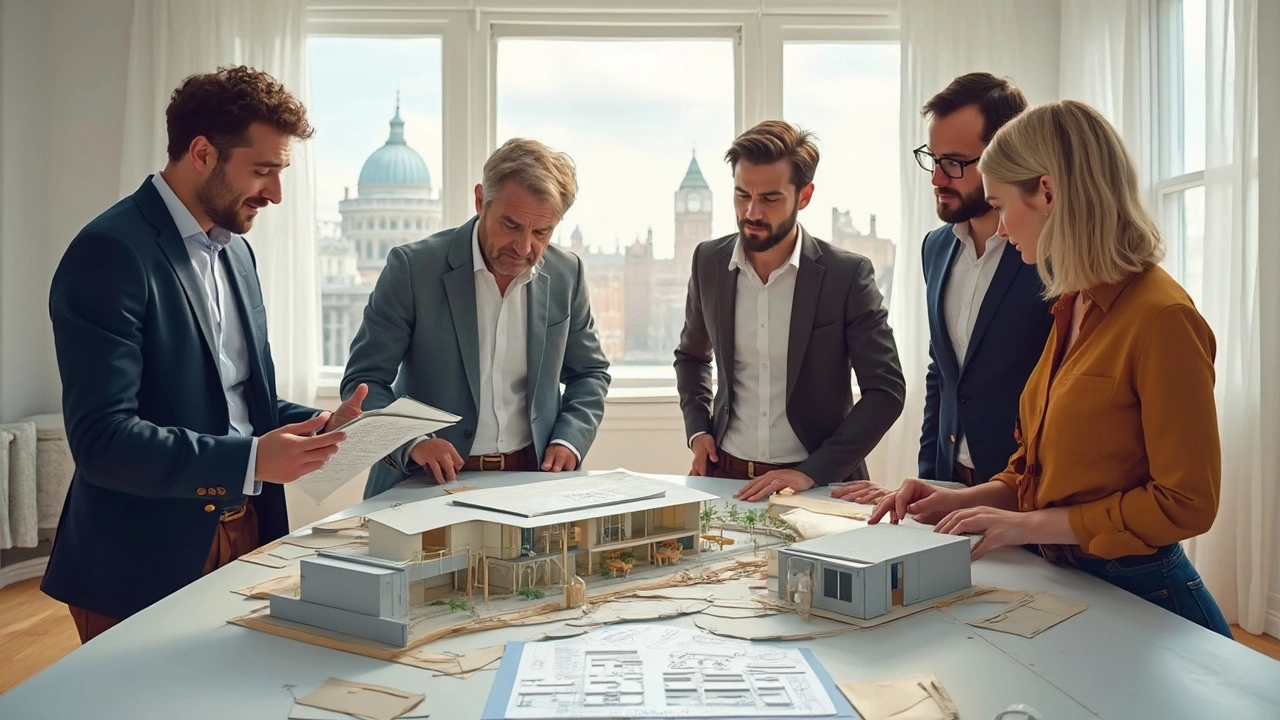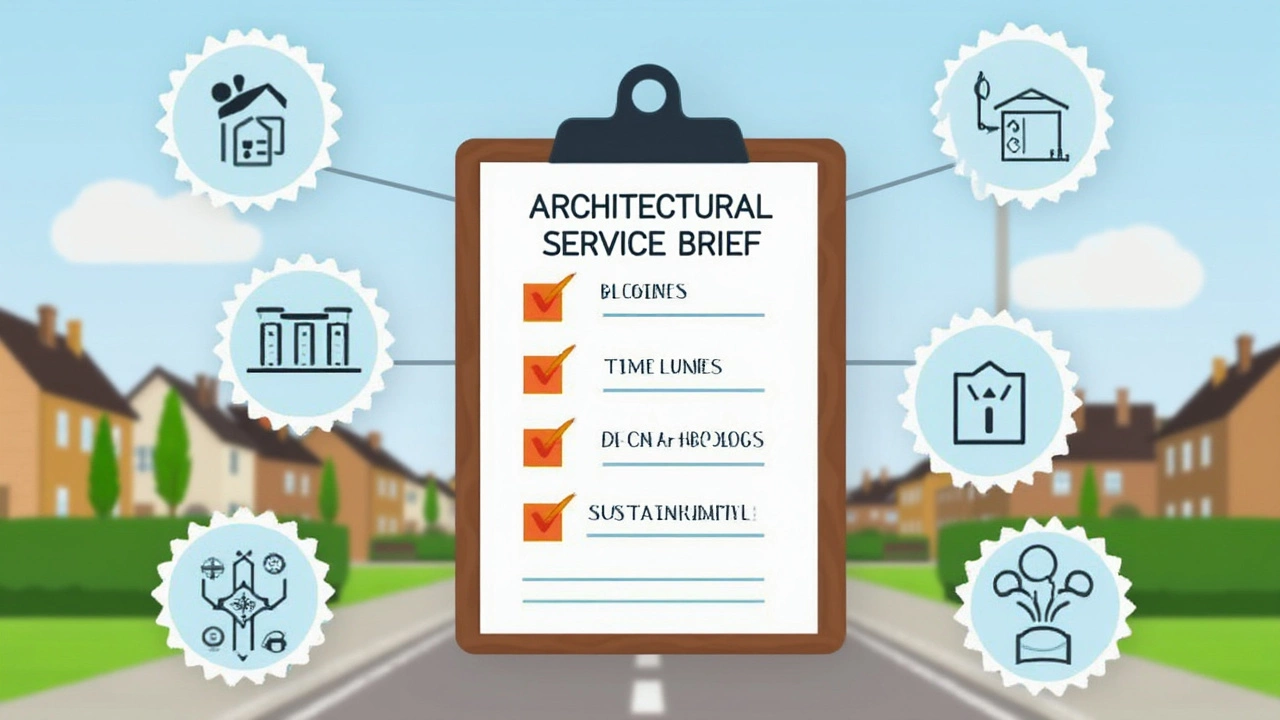Architectural Services Brief: What You Actually Need to Know
 May, 29 2025
May, 29 2025
Architects aren’t mind-readers, and that’s where the brief comes in. Think of it as the GPS for your building project: it tells everyone where you’re going, what you want along the way, and what you definitely do not want. If you skip it or throw one together last-minute, you risk expensive do-overs, missed deadlines, or a building that just doesn’t suit you.
A good architectural services brief spells out your goals, must-haves, and even the stuff you’re worried might bust your budget. It covers simple things—like what you want to build or remodel—and big stuff, like your vision for the space, deadlines, and the quirks of your site. Clients who take the time to get specific avoid endless back-and-forth emails, design disasters, and 'wait, that’s not what I meant' moments.
- What Is an Architectural Services Brief?
- Key Parts Every Brief Should Include
- Why a Good Brief Saves Time and Money
- How Clients and Architects Work Together
- Common Mistakes and Smart Fixes
What Is an Architectural Services Brief?
An architectural services brief sets the direction for a building project right from the start. It’s basically a guide for both the client and architect that lays out what's expected, so no one is left guessing. If you want to hire an architect, this is the first document you’ll swap—it covers your ideas, your budget, your must-haves, and what success looks like to you.
This document isn’t just some formality. In countries like the UK, professional bodies such as the Royal Institute of British Architects (RIBA) actually require a detailed brief for every new project. That means it’s not just smart, it’s also standard practice.
So, what’s usually in an architectural brief? Here’s what most people include:
- Your main project goals (what are you actually trying to build?)
- How much you want to spend (real numbers—not just "low" or "affordable")
- Key deadlines—when you want to start, when you need it finished
- Style preferences, like modern, minimalist, eco-friendly, or something totally different
- Site specifics: where you’re building, local climate, odd-shaped lots, stuff other projects might ignore
The main idea here is clarity. A clear, honest brief keeps everyone on the same page and helps the team avoid wild guesses down the road.
| Quick Stats | Details |
|---|---|
| Projects with detailed briefs | Finish on time 62% more often, according to a 2022 UK construction survey |
| Top reason for budget overruns | Lack of clear brief—cited by 48% of surveyed architects (ArchDaily, 2023) |
| Time saved by using a brief | Average of 15% less project time spent on changes and revisions |
At the end of the day, your architectural brief is like a cheat sheet for turning your project vision into real-life plans. It’s the first step to getting results, not regrets.
Key Parts Every Brief Should Include
A solid brief keeps your project on track. If you’re new to this, don’t just say “I want a building.” Get real with the details. Here’s what every strong brief should spell out:
- Project goals and objectives: What are you trying to build—a home, an office, a cafe? Do you want more light, better flow, or just a fresh look? Be specific, so the architect knows where to start.
- Budget limits: Even a ballpark figure helps. If you don’t mention budget, designers might go wild or too cheap. Either way, you’ll waste time if costs aren’t clear from day one.
- Timeline and key dates: Got a hard move-in date? Need work done before school starts? Add it to your brief. It’s how you avoid future stress.
- Site information: Mention the address, quirks of the land, photos, or old blueprints. If the neighbors are close or the land slopes, call it out early.
- Must-haves and wish-list items: Maybe it’s a giant kitchen island, energy-saving windows, or home office space. Separate your “can’t-live-without” from “nice-to-have” features.
- Design style and vibe: Are you dreaming of modern, traditional, or something no one has seen before? Photos, Pinterest links, or even rough sketches help show what you mean.
- People using the space: A family with young kids, a team needing open workspaces, or a couple downsizing—all have different needs. Tell the architect about who’s going to use what you’re building.
- Legal stuff and restrictions: Include anything you know—planning permissions, zoning laws, or protected trees on site. Surprises here usually cost time and money to fix.
Don’t be afraid to get personal and honest. A detailed architectural brief is what makes everything easier—better ideas, fewer headaches, and a final space that actually fits your life or business.

Why a Good Brief Saves Time and Money
If you want your project to stay on track and under budget, a architectural brief is the way to go. When everyone knows exactly what’s needed, there’s less confusion, fewer changes, and way fewer "I thought you meant…" moments. The biggest cost overruns on building projects usually come from rework—fixing mistakes or making changes because something wasn’t clear in the beginning.
Here’s a real kicker: the Royal Institute of British Architects (RIBA) found that over 60% of projects with unclear briefs ran over budget. That’s not pocket change—small mistakes add up fast when you’re paying for architects, builders, and materials.
A clear brief helps:
- Spot big issues early, so you can fix them while it’s cheap and easy
- Speed up design decisions, so you’re not wasting weeks going back and forth
- Limit change orders, which are some of the priciest headaches in construction
- Keep everyone—clients, architects, and contractors—on the same page, so there’s less stress for all involved
Check out this quick look at how a strong brief can make a difference:
| Project Stage | With Good Brief | With Poor Brief |
|---|---|---|
| Design | No surprises, fast approvals | Repeated changes, slow progress |
| Build | Contractors know what's coming, fewer mistakes | Unexpected costs, on-site confusion |
| Final Result | Matches your vision and needs | Disappointments and "wish we’d said that sooner" |
If you hand your architect a crystal-clear brief at the start, you’ll see results faster and your wallet will thank you. You’re not just saving money—you’re saving yourself drama and endless phone calls down the road.
How Clients and Architects Work Together
The magic happens when clients and architects get on the same page early—and stay there. This isn’t just about handing over a wish list and waiting for magic. It’s a real partnership built on clear talking, sharing ideas, and yes, sometimes even healthy debate. Both sides have a job to do to make sure things run smooth.
Here’s what actually happens in most projects:
- Architectural brief meeting: You and your architect sit down to hammer out your needs—number of rooms, style, budget, and key non-negotiables.
- Site visits: Architects love seeing the space in person. They’ll point out things you might not notice—sunlight angles, weird corners, or building restrictions from the city.
- Feedback loops: Expect to go back and forth. You’ll get early sketches or 3D models, share your thoughts, and get updates as the design evolves. Don't be shy—good architects want honest feedback, not awkward approval.
- Decision checks: There are lots of little choices—materials, floor layouts, window sizes. The architect will flag anything urgent and explain the trade-offs in normal language.
One surprising fact: the Royal Institute of British Architects (RIBA) found that projects with frequent client-architect meetings finished on time about 25% more often than those with minimal check-ins. Constant talking makes a huge difference.
Quick tip—get everything you want in writing, even if it feels obvious. Misunderstandings can stall a project or cost you more money down the road. If you’re not sure about a detail, ask. There are no dumb questions in this process.
Remember, a strong partnership leads to better results. When both sides commit to real, open chats throughout the job, you’re way more likely to get a space that just feels right.

Common Mistakes and Smart Fixes
Plenty of projects hit bumps because the brief is rushed or missing details. One big mistake people make is skipping the details—like leaving out future plans, key preferences, or how many people will actually use a space. Another? Changing your mind about the major stuff halfway through. Both of these drive up costs and drain your time fast.
Here are some common slip-ups people run into with their architectural brief, and what you should do instead:
- Being vague about needs: If you just say "a big living room," you’ll get what the architect thinks is big—not what you mean. Tell them the size you want or what you want that space to do (like "fit 12 people comfortably").
- Forgetting the budget: More than half of all design projects go over budget because costs weren’t nailed down early. Sharing your top budget number gives everyone a reality check from day one.
- Neglecting the site quirks: Things like weird slopes, mature trees, or nearby noisy roads can mess up a design if ignored. Always walk the site with your architect and point out anything odd.
- Ignoring legal rules: Stick to local building codes and neighborhood restrictions. One study found that almost 30% of project delays come from missed or misunderstood regulations.
- Not listing must-haves vs. nice-to-haves: When priorities aren’t clear, you’ll waste design time switching gears. Always spell out your non-negotiables.
If you fix these things up front, planning gets a lot simpler. As Anna Wintle, a longtime project manager at Buildwise, says:
"A brief isn’t just paperwork—it’s about avoiding confusion and making sure everyone’s talking about the same thing. The better the brief, the less painful the process."
Here's a quick data breakdown of how mistakes impact projects, based on a 2023 UK construction industry survey:
| Mistake | % Projects Impacted | Average Cost Overrun |
|---|---|---|
| Vague Brief | 41% | 18% |
| No Budget Details | 34% | 22% |
| Site Issues Missed | 27% | 15% |
The main fix? Lay everything out clearly from the start and keep your architect in the loop whenever things change. Your project—and your wallet—will thank you.
